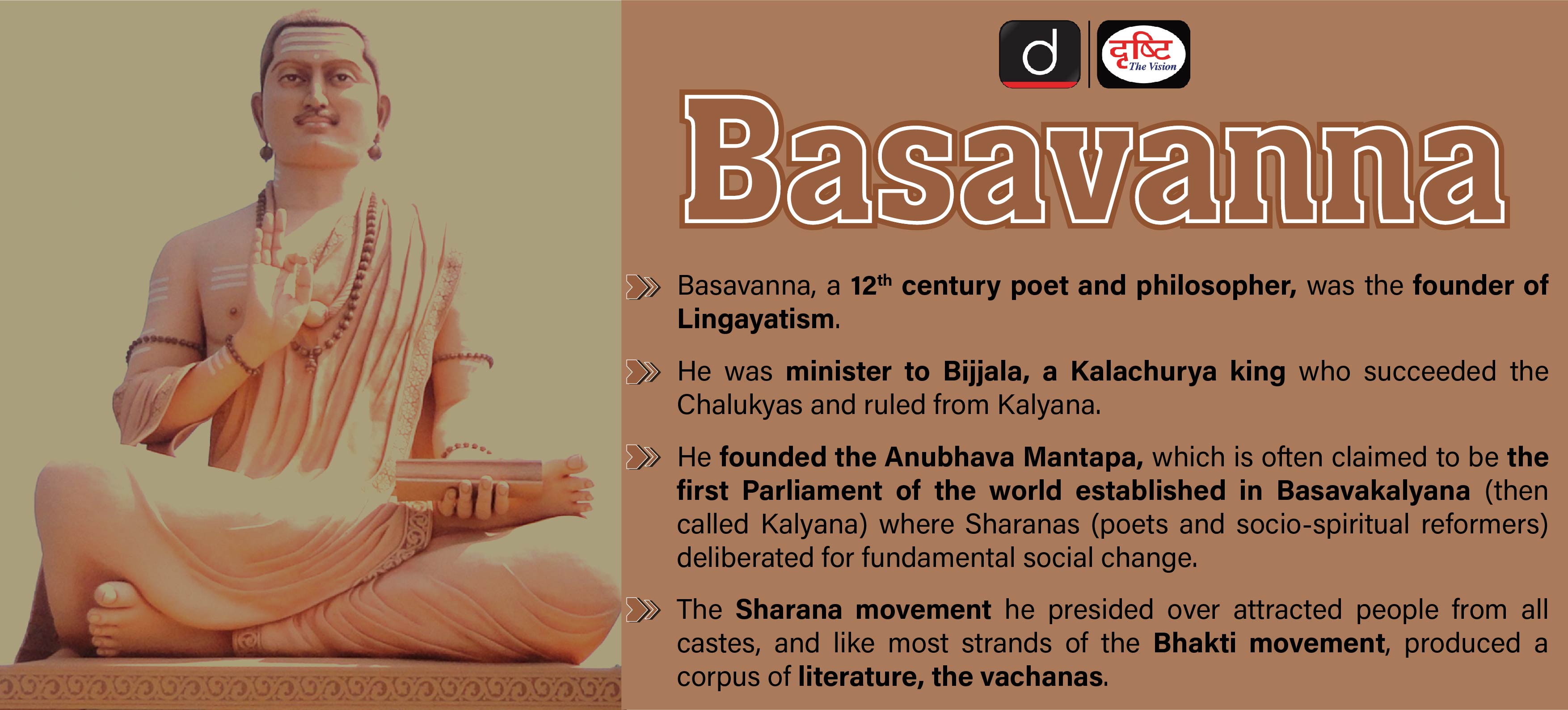Indian History
Basava Jayanti
- 04 May 2022
- 5 min read
For Prelims: Basavanna, Anubhava Mantapa
For Mains: Socio-cultural Reform Movements of South India
Why in News?
The Prime Minister paid tributes to Jagadguru Basaveshwara (Basavanna) on the sacred occasion of Basava Jayanti.
- As per the Hindu calendar, the birth of Basavanna falls on the 3rd day of Vaisahaka month in the Shukla paksha. This usually falls either in April of May of the English calendar.
Who is Basavana?
- About: Basaveshwara was born in Bagevadi (of undivided Bijapur district in Karnataka) in 1131 AD.
- A 12th-century poet and philosopher, who is celebrated and held in high regard, especially by the Lingayat community, as he was the founder of Lingayatism.
- The term Lingayat denotes a person who wears a personal linga, an iconic form of God Shiva, on the body which is received during the initiation ceremony.
- In Kalyana, the Kalachurya king Bijjala (1157-1167, AD) appointed Basaveshwara as a karanika (Accountant) in the initial stage, in his court and later as the Prime minister.
- A 12th-century poet and philosopher, who is celebrated and held in high regard, especially by the Lingayat community, as he was the founder of Lingayatism.
- Main Teachings: His spiritual discipline was based on the principles of Arivu (true knowledge), Achara (right conduct), and Anubhava (divine experience) and it brought a social, religious and economic revolution in the 12th century.
- This path advocates a holistic approach to Lingangayoga (union with the divine).
- This comprehensive discipline encompasses bhakti (devotion), jnana (knowledge), and kriya (action) in a well-balanced manner.
- Social Reforms: Basaveshwara is known to have brought about several social reforms.
- He believed in a society free of the caste system, with equal opportunity for all and preached about manual hard work.
- He also founded the Anubhava Mantapa, loosely translated as the forum of experiences, an academy which included Lingayat mystics, saints, and philosophers.
- Other Socio-Economic Principles: Basaveshwara gave two more very important socio-economic principles.
- Kayaka (Divine work):
- According to this, every individual in society should take up the job of his choice and perform it with all sincerity.
- Dasoha (Equal distribution):
- There must be an equal income for equal work.
- The worker (Kayakajeevi) may lead his day-to-day life by his hard-earned income. But he should not preserve the money or property for tomorrow. He must utilize the surplus money for society and the poor.
- Kayaka (Divine work):
Anubhava Mantapa
- Basaveshwara established the Anubhava Mantapa, which was a common forum for all to discuss the prevailing problems of socio, economic and political strata including religious and spiritual principles along with personal problems.
- Thus, it was the first and foremost Parliament of India, where Sharanas (citizens of welfare society) sat together and discussed the socialistic principles of a Democratic set up.
- All those discussions of Sharanas were written in the form of Vachanas.
- Vachanas were an innovative literary form written in simple Kannada language.
- His practical approach and act of establishment of ‘Kalyana Rajya’ (Welfare state) brought a new status and position for all the citizens of the society, irrespective of class, caste, creed and sex.
- Recently, the Chief Minister of Karnataka has laid the foundation stone for the ‘New Anubhava Mantapa’ in Basavakalyan.
UPSC Civil Services Examination, Previous Year Questions
Q. With reference to the cultural history of medieval India, consider the following statements: (2016)
- Siddhas (Sittars) of Tamil region were monotheistic and condemned idolatry.
- Lingayats of Kannada region questioned the theory of rebirth and rejected the caste hierarchy.
Which of the statements given above is/are correct?
(a) 1 only
(b) 2 only
(c) Both 1 and 2
(d) Neither 1 nor 2
Ans: (c)
Exp:
- Siddha means a person who has attained Siddhi, perfection, or supernatural abilities. In southern India, the tradition of Siddhas emerged as Sittar tradition, which dates back to the 7th century, with a literature of their own. Siddhas worship Shiva and Shakti in their benign, ascetic and fierce forms. They were monotheistic and condemned idolatry. Hence, statement 1 is correct.
- Lingayats, questioned the theory of rebirth and rejected the caste hierarchy.
- Hence, statement 2 is correct.







